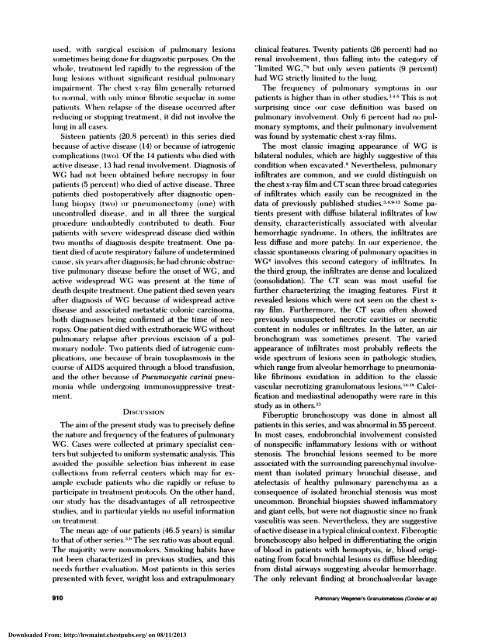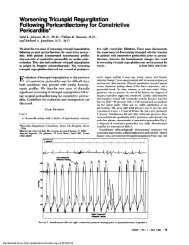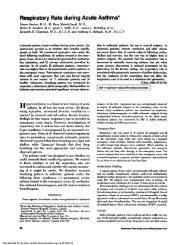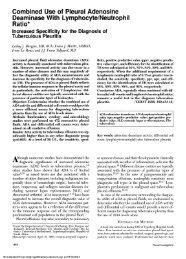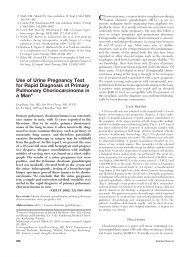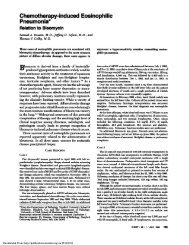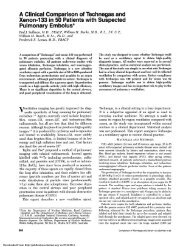Pulmonary Wegener's Granulomatosis*
Pulmonary Wegener's Granulomatosis*
Pulmonary Wegener's Granulomatosis*
Create successful ePaper yourself
Turn your PDF publications into a flip-book with our unique Google optimized e-Paper software.
used , Vitil surgical excisioon of pulmonary lesions<br />
sometimes i)eing done four diagncmstic purposes. On the<br />
V1loole, treatment led rapidly too the regresson of the<br />
bug lesiomos witllouut significamit residual pulnlonary<br />
impairlllellt. The chest x-ray film generally returned<br />
to) oloorillal, with ounly tumor fibrotic sequelae in s(Omne<br />
patielits. When relapse of the disease occttried after<br />
reducing or sto))ping treatment, it did noot involve the<br />
lung in all cases.<br />
Sixteen l)atients (20.8 percent) in this series died<br />
i)ecause oof active disease (14) o)r because of iatrogenic<br />
complications (two). Of the 14 patients who died with<br />
active disease, 13 had renal invo)lvement. Diagnosis of<br />
WC had llO)t i)eeII obtained before necropsy in four<br />
patiellts (5 percent) who died ofactive disease. Three<br />
patients died postoperatively after diagnostic open-<br />
lung biopsy (two) oor pneum(onect(omy (one) with<br />
uncontrolled disease, and in all three the surgical<br />
procedure undoubtedly contributed to death. Four<br />
patients with severe widespread disease died within<br />
twoo Iflooiltils cof diagmlosis despite treatment. One pa-<br />
tient died o)fadute respiratory failure of undetermined<br />
cause, six years after diagnoosis; he had chronic obstruc-<br />
tive pulmonary disease before the onset of WG, and<br />
active widespread WG was present at the time of<br />
death despite treatment. One patient died seven years<br />
after diagnoosis (of WG because of widespread active<br />
disease and associated metastatic colonic carcinoma,<br />
both diagnoses being confirmed at the time of nec-<br />
ropsy. One patient died with extrathoracic WG without<br />
pulmo)nary relapse after previous excision of a pul-<br />
moonary no)dule. Two patients died of iatrogenic com-<br />
plications, tune because of brain toxoplasmosis in the<br />
course ofAIDS acquired through a blood transfusion,<br />
and the other because of Pneunzocystis carinii pneu-<br />
monia while undergoing immunoosuppressive treat-<br />
inent.<br />
DIstTSs1oN<br />
The aim ofthe present study was to precisely define<br />
the nature and frequency (ofthe features of pulmonary<br />
WC . Cases were collected at primary specialist cen-<br />
ters but stll)jected too unifoorm systematic analysis. This<br />
avooided the po)ssible selection bias inherent in case<br />
ccollectioons froom referral centers which may for ex-<br />
ample exclude patients who die rapidly or refuse to<br />
participate ill treatment protocols. On the (other hand,<br />
sour study has tile disadvantages of all retrospective<br />
studies, and in particular yields no useful information<br />
on treatfllent.<br />
The mean age of our patients (46.5 years) is similar<br />
to that ofootiler series.30’ The sex ratio was about equal.<br />
The Inajo)rity were noonsmokers. Smoking habits have<br />
tRot l)eIl characterized in previous studies, and this<br />
needs further evaluation. Most patients in this series<br />
presented with fever, weight loss and extrapulmonary<br />
clinical features. Twenty patients (26 percent) had no<br />
renal involvement, thus falling into the category of<br />
“limited WG,”M but on1y seven patients (9 percent)<br />
had WC strictly limited to) the lung.<br />
The frequency of pulmoonary symptoonis in tour<br />
patients is higher than in other studies.3#{176}’ This is not<br />
surprising since our case definition was based on<br />
pulmonary involvement. Only 6 percent had no) pul-<br />
monary symptoms, and their pulmonary involvement<br />
was found by systematic chest x-ray films.<br />
The most classic imaging appearance of WG is<br />
bilateral nodules, which are highly suggestive of this<br />
condition when excavated. Nevertheless, pulmonary<br />
infiltrates are common, and we could distinguish on<br />
the chest x-ray film and CT scan three broad categ(ories<br />
of infiltrates which easily can be recognized in the<br />
data of previously published studies.3’4’#{176}#{176}#{176}3 Some pa-<br />
tients present with diffuse bilateral infiltrates of low<br />
density, characteristically associated with alveolar<br />
hemorrhagic syndrome. In others, the infiltrates are<br />
less diffuse and more patchy In our experience, the<br />
classic spontaneous clearing of pulmonary o)pacities in<br />
WG4 involves this sec(ond category of infiltrates. In<br />
the third group, the infiltrates are dense and localized<br />
(consolidation). The CT scan was most useful for<br />
further characterizing the imaging features. First it<br />
revealed lesions which were not seen on the chest x-<br />
ray film. Furthermore, the CT scan often showed<br />
previously unsuspected necrotic cavities or necrotic<br />
content in nodules or infiltrates. In the latter, an air<br />
bronchogram was sometimes present. The varied<br />
appearance of infiltrates most probably reflects the<br />
wide spectrum of lesions seen in pathologic studies,<br />
which range from alveolar hemorrhage to pneumonialike<br />
fibrinous exudation in addition to the classic<br />
vascular necrotizing granulomatous lesions. oos Calci-<br />
fication and mediastinal adenopathy were rare in this<br />
study as in others.<br />
Fiberoptic bronchoscopy was done in almost all<br />
patients in this series, and was abnormal in 55 percent.<br />
In most cases, endobronchial involvement consisted<br />
of nonspecific inflammatory lesions with or without<br />
stenosis. The bronchial lesions seemed to be more<br />
associated with the surrounding parenchymal involve-<br />
ment than isolated primary bronchial disease, and<br />
atelectasis of healthy pulmonary parenchyma as a<br />
consequence of isolated bronchial stenosis was most<br />
uncommon. Bronchial biopsies showed inflammatory<br />
and giant cells, but were not diagnostic since no frank<br />
vasculitis was seen. Nevertheless, they are suggestive<br />
ofactive disease in a typical clinical context. Fiberoptic<br />
bronchoscopy also helped in differentiating the origin<br />
of blood in patients with hemoptysis, is, blood origi-<br />
nating from focal bronchial lesions vs diffuse bleeding<br />
from distal airways suggesting alveolar hemorrhage.<br />
The only relevant finding at bronchoalveolar lavage<br />
910 <strong>Pulmonary</strong> Wegeners Granulomatosis (Cordier et a!)<br />
Downloaded From: http://hwmaint.chestpubs.org/ on 08/11/2013


